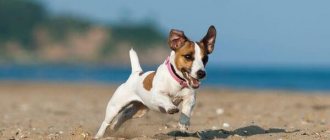Regardless of the breed, size or personality of the dog, daily walks are a vital necessity for your pet. It's not just that dogs need to relieve themselves, but also that these animals need physical activity and the need to sniff new places.
These animals need physical activity
Why does a dog need to walk?
Walking outside is a biological need for all dogs, regardless of breed. If a cat can live its entire life without leaving the house, then for a dog this can turn out very sad.
Although dogs have long been pets, the instincts that unite them with wolves have not gone away.
It is vital for a pet to splash out energy, satisfy its hunting instinct and learn new smells. Note! It is also important for them to communicate on the street and with other dogs, since they are pack animals and communication between relatives is very important for normal socialization.
Unfulfilled dog instincts can, first of all, darken the life of a person himself. Without normal physical activity (especially if the animal is young and active), the dog will chew everything in the house that gets in its way. Sudden aggression and disobedience may also appear.
Separately, it is worth mentioning about sterilized animals. After the operation, their activity decreases due to the fact that they do not have to try to satisfy the need to mate. The dogs become calmer. At the same time, they may begin to eat more. Or the portions of food will remain the same, but due to the fact that you want to run and play less, excess weight will begin to appear.
How long should you walk your puppy for the first time?
The puppy's first walk should not be long. Ideally, the duration of the first outing with your pet should be about 15 minutes. But it is worth noting that the time of this walk may vary depending on the mood and temperament of the puppy. It happens that during the first walk some pets are quite tense, constrained and scared, while others quickly get accustomed to the street and after 5 minutes they are actively exploring the world around them, cheerfully wagging their tail. However, in any case, you should not spend more than half an hour on the first walk.
How many times a day should you walk your dog?
How often should you walk your dog? This question is asked by many people who decide to get a puppy for the first time. After all, walks are an important part of a pet’s life.
Puppies can be walked only after all necessary vaccinations have been completed. Before this, you can walk with the puppy only at the dacha or in a private house that has its own plot. The main thing is that the pet does not come into contact with other animals.
After vaccinations, the puppies are walked for short walks 4-5 times a day. Babies cannot control urination and pee at home. You need to walk older dogs as often as possible and preferably for as long as possible.
Puppies can only be walked after all the necessary vaccinations have been completed.
The main thing is to go outside in the mornings and evenings so that the dog can relieve itself. 20-30 minutes is enough for this. With this regime, you should go out during the day and walk for 1-1.5 hours.
If morning and evening walks last an hour, then you don’t have to go out during the day. It is important that the dog gets tired during the walk.
Important! If you have time to walk your pet more than twice a day, that's even better.
The more often your four-legged friend goes outside, the better for his well-being.
What is the best time to take your pet for a walk?
The animal's walking schedule is determined by the owner. We will give you an example of a typical walking schedule that will help you create a walking schedule in accordance with your criteria.
| morning | day | evening |
| 8:00-8:30 | 16:00-17:30 | 21:00-22:00 |
You can change the duration of your evening walk by shortening it, but compensating for this time by lengthening your morning walk, for example. Here you adjust the schedule purely based on your schedule and capabilities.
Duration of walk and age
First of all, in order to understand how much physical activity an animal needs, it is important to pay attention to age.
How long should you walk your dog depending on age:
- After vaccination, puppies need to be walked for 15-20 minutes 3-4 times a day.
- From 6 months, the duration of the walk increases. 2-3 walks of 30-50 minutes are enough.
- From the age of 1, there comes a period when the body is practically formed and physical activity is at its peak. You need to spend at least 2-2.5 hours outside. This time can be divided into several walks.
- Pregnant dogs are allowed to walk as much as non-pregnant dogs, but without active games or jumping. You can also slightly reduce the duration of the walk. If there are any problems or contraindications, you should consult a veterinarian on this issue.
- Elderly and sick pets should not go for long walks. It’s better to go out more often, but not for long. Again, if there are any illnesses that require you to limit physical activity, you should not force your dog to walk often.
Attention! On average, a healthy adult dog should walk at least 2 hours a day. But the duration of the walk is also affected by the breed of the animal.
Walking rules and regulations
We must not forget about the rules and regulations established in society for walking dogs. This is especially true for densely populated urban areas. Follow these simple guidelines:
- walk your dog on a leash and muzzle in crowded places;
- do not walk your dog on playgrounds or near educational or medical institutions;
- Clean up after your dog using a dustpan, bags or napkins.
The lifespan, health and happiness of your dog largely depends on the correct walking regime, which should be taught from puppyhood. If the dog takes full walks, spends enough energy and receives a positive charge, then he will be healthy, friendly and obedient.
Walking a sick dog
How many times a day you need to walk your dog if it is sick depends on what exactly the pet is sick with. If this is an infectious disease, then going outside is allowed. But it’s worth going out where there are no other dogs, so as not to infect them. If it turns out that while walking, a sick dog collides with a healthy one, under no circumstances should they be allowed to sniff each other, even if the two dogs are familiar and usually play with each other.
Walking a sick pet is discussed with a veterinarian
If the pet is postoperative, going outside must be allowed by the doctor. And in principle, the dog itself is unlikely to want to get up and go somewhere. The body is very weak and must still recover as long as necessary.
In case of other diseases, you should consult a veterinarian.
Attention! Some illnesses do not affect this in any way, while for others, walking is prohibited. For example, for joint diseases, fractures.
Walking is a biological need for dogs
The dog’s need for long walks is due to its characteristics as a biological species. Remember the saying “The feet feed the wolf”? In nature, canines actively move in search of prey, allowing themselves to rest only after a successful hunt.
If you are sure that the domestic dog is the product of a long evolution that has taken it far from the wolf, then watch stray dogs. They are always running somewhere.
So, figuratively speaking, if birds must fly and fish must swim, then dogs must run. This is a biologically fixed instinct that inexorably demands its satisfaction.
When instinct is suppressed...
What happens if you neglect it? Of course, the dog will not die, but those numerous behavior problems that owners so often complain about will arise. Have you probably seen on the Internet a collection of photos clearly depicting the “invasion of Mamai” into an apartment in the absence of the owners?
And this is far from the only consequence - an unrealized instinct leads to many behavioral disorders. After all, only on walks does a dog have the opportunity to meet and build good relationships with other representatives of its species, as well as learn to be indifferent to strangers around.
With the help of walks, the dog learns about the world around him, develops both his senses and his intellect. This landscape is always the same for us. For a dog, there is a huge difference between the usual route yesterday and today.
She reads an open book of smells the way we read a fascinating novel, with an abundance of characters and plot twists. This is why dogs love long walks so much, and it is cruel to deprive them of this opportunity.
During estrus and pregnancy
There are no restrictions on the time pregnant dogs can spend outside in the park or during estrus. Only if there are health problems and the veterinarian does not recommend pregnant dogs to walk a lot. It is not advisable to play active games. Also, if you need to climb the stairs home, and the dog is a dachshund, then it is better to carry the animal in your arms.
During the heat period, you can walk and play as usual. You should not allow contact with male dogs at this time. You may not keep track and then unwanted puppies will be born.
What you need to know about a dog walking business
Part-time work as a dog walker is becoming increasingly popular, especially in big cities. The advantage of such work is that you can still be a minor, and the amount of work depends on the amount of free time.
Active games with dogs
If a person has decided to seriously engage in such a business, he needs to collect initial investments to start. As a rule, no more than 20-30 thousand rubles are required*. This money is spent on designing advertising leaflets and developing a logo, creating a website, registering as an individual entrepreneur (individual entrepreneur) for emergencies, paying insurance and state fees, and, of course, purchasing the necessary equipment.
For your information! As practice shows, a business pays off within the first two months of operation.
You can be a dog walker from the age of 14; this is the best option for earning money for your first pocket money.
How much can you earn
A dog walker, for example, in a large city can earn from 200 to 600 rubles for one walk lasting 1-1.5 hours, depending on the size of the pet. The availability of additional options, for example, training during a walk, also plays a role in pricing. In Moscow, in this case, the price immediately increases by about 300 rubles.
In addition to training, you can feed the animal after a walk and wash its paws; an additional fee is also charged for all this. In short, in 2-4 hours a day, doing not very difficult work, you can earn 400-1500 rubles.
Important! In the regions they will pay less for this service.
A dog is a person’s true friend, but the owner must understand that this is not only joy and carefree, but also a great responsibility. If during a walk you cannot find a common language with your pet, then it is better to seek advice from a dog handler. Specialists analyze and correct animal behavior through exercises.
*Prices are current as of December 2022.
Depending on the breed
How many times a day to walk your dog also depends on the breed. For example, decorative Yorkshire terriers, Chihuahuas, Spitz dogs, pugs and other small dogs do not need long walks. Moreover, these breeds do not require daily trips outside. Representatives of these varieties can be trained to use a litter box at home. True, it is advisable to do this from childhood, as soon as the puppy appeared in the house.
Pugs have a lazy character and sometimes don’t even want to get up from their bed. Dwarf dogs have enough activity at home (especially if it is large) and games with the owner. For a little Chihuahua, just running a couple of laps around the house is enough for her to get tired and fall asleep.
Hunting dogs, such as beagles, Jack Russell terriers, spaniels, and dachshunds, need a lot of walks. The longer they are, the better. This also applies to mestizos. If one of the parents was a hunting dog, then the physical activity should be great.
Large dogs, such as Labradors, retrievers, shepherds, and pit bulls, also need prolonged exposure to the street and active games.
However, even if a small breed dog lives in the house, he should be allowed to go out into the fresh air a couple of times a week to communicate with his relatives and smell new smells.
Dog walking law in force
How much dry food does a cat need per day: table
Keeping and walking dogs in public places is regulated by not one, but several laws. Today in Russia there is a whole set of rules that establish not only the responsibilities, but also the rights of dog owners.
The Federal Law is not yet fully in force. Many clauses officially come into force only on January 1, 2022. We are talking about a ban on walking a potentially dangerous breed without a leash and muzzle, regardless of location.
Current laws on keeping and walking
Also, January 1, 2022 will become a kind of milestone for people who have or want to have representatives of prohibited breeds. If the dog was purchased before January 1, then it must be kept until its natural death.
Note! The new law does not include rules about paying taxes on pets. It does not contain requirements for mandatory microchipping.
Where is it legal to walk your dog?
According to the law, pets without a muzzle and a leash must walk in an area designated specifically for dog training.
Exterior view of walking areas
The following requirements are put forward for these sites:
- a distance of at least 40 meters from socially significant objects;
- location at a distance of at least 25 meters from residential buildings;
- area of at least 400 square meters.
Note! At such sites, the floor covering should be changed at least once a year.
Responsibility for walking dogs
For violating the rules for keeping a pet, 3 types of charges can be brought forward:
- civil;
- administrative;
- criminal.
There are separate grounds and procedures for attraction.
Why owners don't walk their dogs enough
It's hard to say why some owners don't walk their four-legged friends as much as they need to. The reason depends on each individual. Many people get dogs mindlessly because they feel like it or because it's a cute little puppy.
But the animal has its own needs, and if a person is not ready to sacrifice personal free time, go outside in the rain, snow or frost, get up early before work and go for a walk with the dog after work, then he should not get one.
Without proper physical activity, your pet's energy will be spent in unnecessary ways.
Someone may think that a 20-minute walk in the morning and evening will be enough, but then questions arise as to why the dog chewed all the furniture and shoes in the house. Without proper physical activity, the pet's energy will splash out in this way. And you don't need to blame the dog for this. Only the owner is to blame for this.
Note! Before getting a dog, you need to realize that this is not a cat that can stay home all its life and feel great. Especially if the choice fell on a hunting breed or other large animal.
Make walking with your puppy safe
Carefully monitor the puppy’s reaction to passing traffic and, if frightened, distract it with treats, stroking, and play. Pay attention to the puppy's attitude towards strangers. The best reaction to strangers on the part of a puppy is indifference. Do not let your dog bark at strangers, this is unpleasant for others and spoils the impression of the dog. Again, distract your pet from barking with play or avoid meeting strangers for a while.
During walks, the baby should not freeze, so do not let him sit in one place, he should move.
Closely monitor your puppy during walks and do not allow him to pick up food scraps, sticks, garbage and other objects from the ground. You can offer a treat or toy in return.
Be careful when crossing the road and do not walk with your puppy without a leash along highways.
It is very important to choose the right collar and leash for your dog. The dog needs to be accustomed to a collar and leash gradually and very carefully. The puppy should not have any unpleasant sensations when putting on the collar and moving on the leash, he should not be afraid of them and, of course, should not resist. The collar must match the size of the dog and should not be stiff or heavy. For smooth dogs, it is advisable that it be softly lined. The collar should have a ring for attaching a leash to it.
The puppy should not have any unpleasant sensations when putting on the collar and moving on the leash, he should not be afraid of them and, of course, should not resist.
You should not buy expensive collars, because the puppy is growing and they have to be changed very often. It is recommended to purchase a collar made of genuine leather with a soft lining. As for puppies of small breeds, sometimes they wear a harness instead of a collar.
In case your little one gets lost, attach a tag with the address and your phone number.
Why is it good to walk your dog?
Walking is beneficial not only for dogs, but also for the owners themselves. If when it’s warm you still want to go outside, then with the onset of cold weather this desire becomes less and less. But dog lovers leave the house even in the rain or in the snow. This in turn increases immunity, strengthens the cardiovascular system, musculoskeletal system, and reduces the risk of developing varicose veins. This is especially useful for those people who have a sedentary job and spend a lot of time at the computer.
What other benefit could there be from hanging out together?
Social skills
This may sound strange, but not only the dog gets to know its relatives, but also the person can make new acquaintances. Dog owners often have to stop for two dogs to sniff each other and play. Often a conversation starts between people. It often turns out that in addition to raising a dog, people have other common interests. As a result, the pets unite them.
Maintaining health
Physical activity is never superfluous. This applies to both the four-legged friend and the person himself. During communication and games, an attachment hormone is produced between a person and his pet, which in turn has a positive effect on the health of both.
You can channel your energy in the right direction
If in the house, being alone, the dog chews everything he sees, it means he lacks physical activity. Playing for long periods of time outdoors will help solve this problem.
In summer, you can take a ball with you or throw a regular stick. In winter, when there is wet snow, you can throw snowballs. The pet will get tired very quickly, because running in wet snow is hard, but fun, and will come home calm. The main thing is that everyone will be happy, and the things in the house will remain unharmed.
Snowball fights in the park will benefit both the dog and the household
In order for your pet to always be healthy and satisfy its instincts, daily walks are required. While you are outside, you can not only walk, but also play active games. For example, throwing a ball or a stick, hiding treats and much more. In winter you can play in the snow. This way the dog will get tired faster and will not have the strength to entertain itself at home.
Puppy from 3 to 4 months. Part 4
And again about walks. Before this, we talked exclusively about walking on a leash. What about free walks?
Are they necessary? And when? In my opinion, they are absolutely necessary. And the sooner you start walking your dog without a leash, the better you will be able to do this as he grows up. But one should also take into account objective reality, the dangers that threaten a small puppy without a leash. Therefore, here are some recommendations: how to properly walk without a leash.
If you are the happy owners of a fenced area, then there is no problem; you can start walking even before the end of the post-vaccination quarantine, if there are no strangers or animals in the area.
The situation is also simplified if there is a quiet place nearby that is clearly visible and away from the roadway (a field, the shore of a bay...). If you don’t have such a place, I would recommend walking on a leash for at least the first 2-3 weeks, until the puppy gets used to the street and gets used to the equipment. During this time, your connection with him will strengthen, and he will begin to respond to your voice on the street. And if something frightens the puppy, it is more likely that he will rush to seek salvation from you.
For a walk without a leash, choose a familiar place, far away from the roadway. The most important rule I want to convey is - be active! After letting the puppy off the leash, move, invite him to play and run. Call them over and give them a treat. Offer to play with toys - perhaps not the first time, but you will succeed (remember - we play “toy hunt”, the puppy’s very first game). Move, call the puppy to follow you. Comment on his actions (“What did you find? A stick? Well done! And this is a bush. And someone left this letter for you. And this is a squirrel...”). And further. You will definitely encounter situations that will become stressful for you. You can't foresee everything. For example, on one of our walks in the forest, Emma and I met a skier. Emma was very scared and ran away. I follow her, asking the skier in as calm a voice as possible to stop and not scare the little puppy. Then she brought Emma back with dances and treats and even got her to walk past the skier to me the third time. There will be stress. But it is your choice whether to walk on a leash all your life or not. I choose walks in forests and fields without a leash. This is one of the greatest pleasures in this world, in my opinion.











